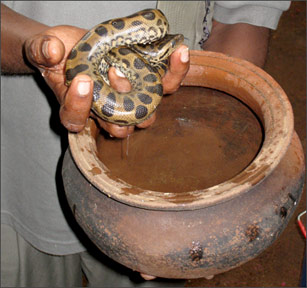|
An Asian record:
Birth of anacondas at National Zoological Gardens, Dehiwela
By Rosanne Koelmeyer Anderson
[email protected]

Each new born was kept in clay pots of water after birth |
 |
Adapting to
their new habitat .
Pix: Rosanne Koelmeyer Anderson |
Eunectes murinus are back! But if you are ‘Ophidiophobic’ it may not
turn you on to drive down to the National Zoological Gardens, Dehiwela
to avail yourself of a rare encounter but its worth the while.
On the other hand it is not uncommon to shudder instantaneously at
the thought: after all, most human beings are genetically predisposed to
being afraid of snakes and it is probably one of the commonest phobias.
However, there is no reason to quiver for these aquatic boas are under
conservation.
The pair of anacondas (Eunectes murinus) the heaviest snakes in the
world, male and female which were brought down from the Pleasant City
Zoo in Chez Republic on June 11, 2003 subsequent to an animal exchange
program created history in the Asian region last Saturday, July 12 at
5.05 p.m. by giving birth to twenty three anacondas, the world’s
heaviest snakes at the National Zoological Gardens, Dehiwela.
The twenty anacondas which survived were in quarantine until
Wednesday and released in groups of five into huge tank enclosures at
the reptilian section of the National Zoological Gardens at Dehiwela.
Deputy Director Dhammika Malsinghe, in an interview with the Sunday
Observer’ said “the baby reptiles, the six males which are said to be
more striking, darker in colour and larger than the fourteen females who
were about 1 1/2 feet in length at birth, had white marble like eyes and
were yellow in colour.
These amazing ovoviparious animals - eggs are incubated internally -
give birth to live young as the eggs hatch inside their stomach after a
gestation period of about a year and are said to have a life span of
about 30-35 years”.
Although snakes have no ears they can detect vibrations and their
tongues are sensitive to smell, taste and touch. The male and female
species of the anaconda are identified by inserting an instrument, ‘the
jambaliya’ which is put into the tail end of the snake.
If the instrument goes in more than an inch the snake is identified
as a male and if it penetrates less than an inch then it could be called
a female, the zoo’s reptilian caretaker, Hemasiri Peiris said.
Incidentally, this snake couple had spent five years, one month and
one day before celebrating the birth of their two dozen giant offspring
amidst a similarly tropical and natural habitat. The reptilian babies
were put into clay pots which contained water where they coiled
themselves up and spent their first few days.
They will be fed by the reptilian authorities with two-day-old rat
each initially and day old chicks in a weeks time. Although anacondas
are fed only once a week, the mother anaconda is however being fed with
50 chicks a day since giving birth. Like after child birth, recuperation
will take time: the mother anaconda will also feel out of sorts for
about two months, reptilian authorities say.
Meanwhile, authorities of the National Zoological Gardens say the
condition of the mother and the twenty baby anacondas are fine and the
authorities would be entering into animal exchange programs and dispose
of them as soon as possible as these reptiles grow to be huge in size.
They are the heaviest and the second longest snakes which could grow
as much as 30 feet. The longest snake being the Reticulated python, a
member of the Boidae family. The Deputy Director said “at the beginning
of each year a wanted and surplus list of animals is prepared. For the
year 2007 10 to 12 animals have been cited on the wanted list while
about 15 species have been included in the surplus list.
However, the Department of Animal Production and Health has
temporarily suspended the exchange of birds due to the prevailing ‘Bird
Flu’.
The Boidae family species which are basically of two types, green and
yellow have been spotted near rivers, swamps and pools of the Amazon
rainforest and are known to feel at home in water, rather than on land
while some are bred in captivity in zoos.
The green anaconda, the ambush predators are said to be more massive,
are much more mobile in the water than on land, generally spend most of
their time in or near water and eat just about any animal of appropriate
size including each other and other reptiles, fish, birds, rodents,
pigs, and monkeys while the yellow anaconda is slightly smaller in size.
Anacondas, although not poisonous are constrictors. They coil firmly
around their prey until they strangle and suffocate them. Though it may
sound petrifying the anacondas were somewhat interesting to the observer
for ‘general observation. |
